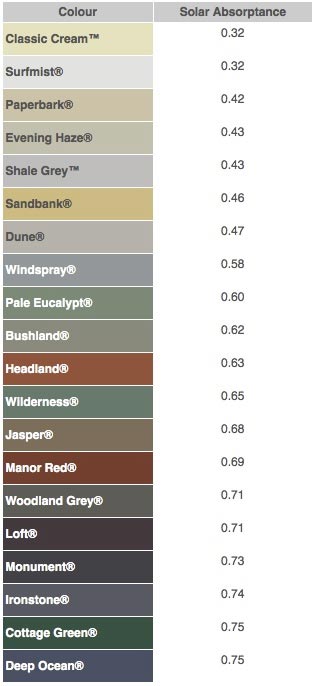This is actually a loaded question – the answer is yes, it does affect the energy efficiency of your house, with respect to the energy required to heat and cool it.
But not how you might think; it’s not as simple as light coloured roofs are better. This blog post explains a bit of the science behind how both the roof colour and material affects the thermal control of your house, and how good design decisions can improve the energy efficiency of your new home or renovation.
If you should ever have the opportunity to view the Perth suburbs from the air, the majority of roofs on Perth houses are made from either tiles (eg. clay, cement, possibly slate) or sheet metal (also known as metal deck), and come in a wide variety of colours and finishes. And from the air, you start to realize just how much impact the roof can have on the overall thermal performance of your home – in most cases, it represents the greatest surface area exposed to solar radiation, and also represents a signficant area through which conduction via the air can occur – about 25% of heat gains and losses occur through the roof in a typical residential building.
Let’s start the discussion with a little bit of background information on solar radiation. Without getting bogged down in the physics of it all, it’s important to remember that radiation from the sun is made of different wavelengths, or frequencies. When it comes to building performance, the main wavelengths of radiation we are concerned with are the visible light (380-780nm) and infrared (700-10,000,000nm) spectrums, however solar radiation is also composed of x-rays, ultraviolet (UV) and radio wave frequencies.
The colour of the roof affects a material’s thermal property known as solar absorptance – basically, the amount of solar radiation that is absorbed by a surface. It is measured as a decimal value between 0.0 and and 1.0 – so for example, if a particular surface has a solar absorption value of 0.5, this means that 50% of the solar radiation that hits will be absorbed.
The image right is a screenshot from the Bluescope® website, which shows the solar absorption values for the range of available Colorbond® colours. As you can see, the darker the colour, the higher the solar absorptance. However, it should be said that colour is not the sole determiner of solar absorptance; a number of heat reflective paints and coatings exist that can help reduce the solar absorptance of a surface, even for darker colours. For example, all of the Bluescope metal products that have a Colorbond® coating now also feature a special Thermatech® coating that improves the the solar absorptance for their entire range of colours. However, lighter colours still have a lower solar absorptance – I’ll explain why this is important in just a moment.
The opposite of solar absorption is solar reflectance, which the amount of solar radiation that gets reflected by surface. Again this is affected by colour, and is directly related to solar absorptance – remember how absorption is measured on a scale between 0.0 and 1.0? So is reflectance, which is equal to 1.0 minus the solar absorption eg. If the solar absorptance of a surface is 0.4, then the reflectance is equal to 0.6, being 1.0 minus 0.4. So, if you know the solar absorptance, you can calculate the solar reflectance, and vice versa.

SOLAR ABSORPTANCE OF COLORBOND COLOURS
So how does the solar absorptance and reflectance affect the thermal performance of our homes? As you’ve probably worked out by now, the more solar radiation that a surface absorbs, the more heat it will transfer via conduction, which ultimately ends up inside of our homes. Now this can be both a good and a bad thing – we don’t want extra heat inside our houses in summer, but it could be beneficial to have some extra warmth during winter. But given that we can’t change the colour of our roofs to suit the season, which condition should we design for?
The following graphs show the space heating and cooling loads for an air-conditioned home situated in Perth, Western Australia. The first graph is for a building with a light-coloured, low solar absorptance roof, while the second graph shows the same building with a dark-coloured, high solar absorptance roof:

As you can see, having a high solar absorptance roof dramatically increases the cooling load throughout the warmer months of the year, by as much as 20% in the hottest month, February. And while there is a very slight decrease in the heating load of the building from June through to August, any benefit this may provide is more than cancelled out by the increased cooling load during summer.
When it comes to the solar passive design of your new home, a dark-coloured, high solar absorptance roof is not a good idea, as it will make it more difficult to achieve a thermally comfortable internal environment during summer. Even if you intend on installing air-conditioning, a high solar absorptance roof will mean the air-conditioning will have to work harder to cool down your home, meaning higher electricity costs and increased carbon emissions.
Design tip: To improve the solar passive design and thermal comfort of your home, choose a roof surface that has a low solar absorptance (and thus high solar reflectance) to reduce the adverse impact of solar radiation.



